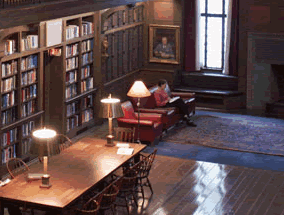| Sterling Memorial |
| Archives |
| Music |
| Divinity |
| Forestry |
| Kline Sciences |
| Medical Historical |
| Exhibit Map |
| Alexander
von Humboldt, Kosmos, 1845
Standard accounts of the history of ecology
look to Humboldt’s work in botanical or
plant geography as one important foundation.
Humboldt’s mapping of species (and associations
of species) made geography (places) newly important
to botany. In comparison to Darwin’s dynamic
evolutionary theory--with which it merged in
the second half of the 19th century as the story
goes--Humboldt’s work is seen as a static
taxonomy of species. This account ignores that
Humboldt studied in the 1780s with Georg Forster
in plant physiology. Humboldt’s vision
of nature and of the Cosmos is not static, but
physiological! In Cosmos, his last
great synthetic work, Humboldt describes the
evolution of the Universe, Solar System, and
the Earth. In discussing the “universal
fluctuation of phenomena,” he believed
that “the discovery of every separate
law of nature leads the establishment of more
general laws.” Citing Carus the celebrated
physiologist, Humboldt considered Nature as
“that which is ever growing and ever unfolding
itself into new forms.” Reflecting on
the immense variety of organic forms, he saw
in the periodic transformation of animal and
vegetable productions, the primordial mystery
of all organic development--that same great
problem of Metamorphosis.” |
| Case 1 |
| Case 2 |
| Case 3 |
| Case 4 |
| Case 5 |
| Case 6 |
| Case 7 |
| Case 8 |
Whitney Humanities Center
Yale University
53 Wall Street
P.O. Box 208298
New Haven, CT 06520-8298
Office: (203).432.3112
lloydackert@sbcglobal.net
Yale University School of Medicine Building
333 Cedar Street
New Haven, CT
Map, Directions
